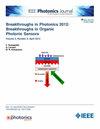High Power 780 nm Broad-Area DFB Laser With Narrow Spectral Width
IF 2.1
4区 工程技术
Q3 ENGINEERING, ELECTRICAL & ELECTRONIC
引用次数: 0
Abstract
The 7xx nm laser diode is the core pump source for Diode Pumped Alkali Vapor Laser (DPAL). For these applications, high power and narrow spectral width are essential. Traditional Fabry-Pérot (FP) diode lasers can provide high continuous output power, but their spectral width is too broad for many applications. By burying a Bragg grating within the semiconductor, a narrow and temperature-stable spectrum can be achieved. In this paper, we investigate the factors limiting the power enhancement of distributed feedback (DFB) lasers and characterize the grown gratings using transmission electron microscopy. We discuss the effects of grating coupling strength, wavelength detuning, and oxygen contamination in the grating region on performance. Under optimized growth conditions, a high-performance 780 nm DFB laser based on InGaAsP/InGaP gratings has been developed, achieving a continuous output power exceeding 10 W, which is the highest power for a 780 nm DFB laser to date. The spectral linewidth (FWHM) is less than 0.5 nm, and the device maintains locking across the entire operating current and a wide temperature range.高功率780nm窄谱宽广域DFB激光器
7xx nm 激光二极管是二极管泵浦碱蒸汽激光器 (DPAL) 的核心泵浦源。对于这些应用,高功率和窄光谱宽度是必不可少的。传统的法布里-佩罗特(FP)二极管激光器可以提供较高的连续输出功率,但其光谱宽度过宽,不适合许多应用。通过在半导体中埋入布拉格光栅,可以实现窄且温度稳定的光谱。在本文中,我们研究了限制分布反馈 (DFB) 激光器功率增强的因素,并利用透射电子显微镜对生长的光栅进行了表征。我们讨论了光栅耦合强度、波长失谐和光栅区域氧污染对性能的影响。在优化的生长条件下,我们研制出了基于InGaAsP/InGaP光栅的高性能780 nm DFB激光器,连续输出功率超过10 W,这是迄今为止780 nm DFB激光器的最高功率。光谱线宽(FWHM)小于 0.5 nm,而且该器件在整个工作电流和宽温度范围内都能保持锁定。
本文章由计算机程序翻译,如有差异,请以英文原文为准。
求助全文
约1分钟内获得全文
求助全文
来源期刊

IEEE Photonics Journal
ENGINEERING, ELECTRICAL & ELECTRONIC-OPTICS
CiteScore
4.50
自引率
8.30%
发文量
489
审稿时长
1.4 months
期刊介绍:
Breakthroughs in the generation of light and in its control and utilization have given rise to the field of Photonics, a rapidly expanding area of science and technology with major technological and economic impact. Photonics integrates quantum electronics and optics to accelerate progress in the generation of novel photon sources and in their utilization in emerging applications at the micro and nano scales spanning from the far-infrared/THz to the x-ray region of the electromagnetic spectrum. IEEE Photonics Journal is an online-only journal dedicated to the rapid disclosure of top-quality peer-reviewed research at the forefront of all areas of photonics. Contributions addressing issues ranging from fundamental understanding to emerging technologies and applications are within the scope of the Journal. The Journal includes topics in: Photon sources from far infrared to X-rays, Photonics materials and engineered photonic structures, Integrated optics and optoelectronic, Ultrafast, attosecond, high field and short wavelength photonics, Biophotonics, including DNA photonics, Nanophotonics, Magnetophotonics, Fundamentals of light propagation and interaction; nonlinear effects, Optical data storage, Fiber optics and optical communications devices, systems, and technologies, Micro Opto Electro Mechanical Systems (MOEMS), Microwave photonics, Optical Sensors.
 求助内容:
求助内容: 应助结果提醒方式:
应助结果提醒方式:


